

|
| POLSKA | POLAND |
| województwo: Dolnośląskie | voivodship: Lower Silesia |
| miasto na prawach powiatu: Wrocław | city: Wrocław |
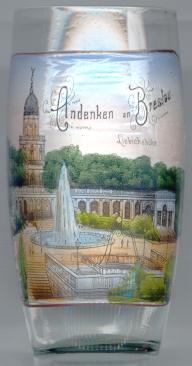 Wrocław is situated at the river Odra (Oder) at the mouth of the river Oława (Ohle) in Lower Silesia and is one of the oldest cities in Poland.
Wortizlawa (first mentioned around 900) began to develop at the site of a castle that was founded presumably by the Bohemian Duke Wratislav I (d.912). The bishopric of Wrocław
was established in 1000. In 1163 it became the seat of the Polish dukes of the Piast family. The rights of a town were granted in 1242. Further privileges,
such as having a town council, according to German town charter of Magdeburg, were granted in 1261. At the turn of the 14th century Wrocław was one of the
largest cities in Europe, having more inhabitants than e.g. Gdańsk (Danzig), Königsberg (now Kaliningrad), or Vienna.
Wrocław became part of the Kingdom of Bohemia in 1335, and from 1526 was ruled by Habsburg Austria.
From the 14th until the 16th century it was a member of the Hanse federation of German trading cities.
In 1741/42, most of Silesia, and with it Wrocław, became part of Prussia and the town became one of the largest Prussian fortresses.
After a period of French occupation during the Napoleonic wars (1806–1808), the city walls were demolished and Wrocław incorporated its suburbs and
several neighbouring villages. The industrial development during the 19th century was boosted by the opening of the first railway line in 1842. Soon, Wrocław
became one of the busiest railway junctions in Europe. The development of the city was abruptly stopped by World War II. It was declared a fortress (Festung Breslau)
in 1944. After its capitulation in May 1945, 70% of the city lay in ruins. Since then, many of its former medieval and Baroque buildings have been rebuilt, among them
such famous sights as the cathedral, the church of St. Elisabeth, the cloth halls, and the town hall.
Together with Donostia-San Sebastián (Spain), Wrocław was selected to be European Capital of Culture for 2012.
Wrocław is situated at the river Odra (Oder) at the mouth of the river Oława (Ohle) in Lower Silesia and is one of the oldest cities in Poland.
Wortizlawa (first mentioned around 900) began to develop at the site of a castle that was founded presumably by the Bohemian Duke Wratislav I (d.912). The bishopric of Wrocław
was established in 1000. In 1163 it became the seat of the Polish dukes of the Piast family. The rights of a town were granted in 1242. Further privileges,
such as having a town council, according to German town charter of Magdeburg, were granted in 1261. At the turn of the 14th century Wrocław was one of the
largest cities in Europe, having more inhabitants than e.g. Gdańsk (Danzig), Königsberg (now Kaliningrad), or Vienna.
Wrocław became part of the Kingdom of Bohemia in 1335, and from 1526 was ruled by Habsburg Austria.
From the 14th until the 16th century it was a member of the Hanse federation of German trading cities.
In 1741/42, most of Silesia, and with it Wrocław, became part of Prussia and the town became one of the largest Prussian fortresses.
After a period of French occupation during the Napoleonic wars (1806–1808), the city walls were demolished and Wrocław incorporated its suburbs and
several neighbouring villages. The industrial development during the 19th century was boosted by the opening of the first railway line in 1842. Soon, Wrocław
became one of the busiest railway junctions in Europe. The development of the city was abruptly stopped by World War II. It was declared a fortress (Festung Breslau)
in 1944. After its capitulation in May 1945, 70% of the city lay in ruins. Since then, many of its former medieval and Baroque buildings have been rebuilt, among them
such famous sights as the cathedral, the church of St. Elisabeth, the cloth halls, and the town hall.
Together with Donostia-San Sebastián (Spain), Wrocław was selected to be European Capital of Culture for 2012.
The collonades and tower (32 m) on the  Liebichshöhe, today Wzgórze Partyzantów (Partisan Hill) [left]
were created in 1866–67 by the factory owner Liebich. The tower does not exist any more today.
Liebichshöhe, today Wzgórze Partyzantów (Partisan Hill) [left]
were created in 1866–67 by the factory owner Liebich. The tower does not exist any more today.
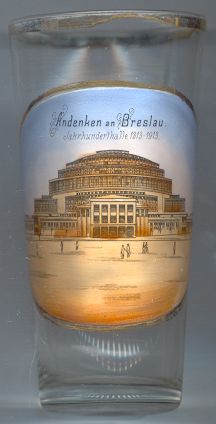
The  Centennial Hall (in German: Jahrhunderthalle, today Hala Ludowa, People's Hall) was built in 1911–1913 to commemorate
the Battle of the Nations (Völkerschlacht) which took place near Leipzig in 1813. Between the 16th and the 19th of October of that year, the army
of Napoleon was defeated by the allied armies of Prussia, Austria, Russia, and Sweden. The battle claimed 85,000 dead and about 100,000 wounded.
The Centennial Hall of Wrocław was built by the architects Max Berg and Willi Gehler. The huge concrete dome of the building has an inner diameter of 65 m.
The hall originally also housed the world's once largest organ, built in 1912–1913. At that time it had 200 stops, 5 manuals and 15,133 pipes.
The vast dimensions of the organ made it necessary that a competely new, electric, technology had to be invented to connect the manuals and pipes. In 1937,
the organ was even enlarged by the addition of further 20 stops. The organ was dismantled in 1946 and its components were used to create three new organs
(the largest part of the old organ, 85 stops, was used for the cathedral of Wrocław).
Centennial Hall (in German: Jahrhunderthalle, today Hala Ludowa, People's Hall) was built in 1911–1913 to commemorate
the Battle of the Nations (Völkerschlacht) which took place near Leipzig in 1813. Between the 16th and the 19th of October of that year, the army
of Napoleon was defeated by the allied armies of Prussia, Austria, Russia, and Sweden. The battle claimed 85,000 dead and about 100,000 wounded.
The Centennial Hall of Wrocław was built by the architects Max Berg and Willi Gehler. The huge concrete dome of the building has an inner diameter of 65 m.
The hall originally also housed the world's once largest organ, built in 1912–1913. At that time it had 200 stops, 5 manuals and 15,133 pipes.
The vast dimensions of the organ made it necessary that a competely new, electric, technology had to be invented to connect the manuals and pipes. In 1937,
the organ was even enlarged by the addition of further 20 stops. The organ was dismantled in 1946 and its components were used to create three new organs
(the largest part of the old organ, 85 stops, was used for the cathedral of Wrocław).
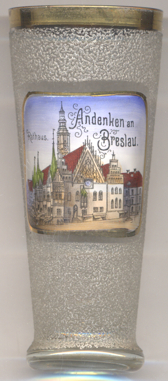
The Gothic  Town Hall [left, no. 1688] is certainly one of the most important architectural monuments in Wrocław.
It was built in 1471–1504. The tower has a height of 66 m. The building was repeatedly adapted throughout the
following centuries so that it also contains important elements of the Baroque period. It was here that the citizens of Wrocław
rendered homage on 7 November 1741 to King Friedrich II of Prussia after he had conquered Silesia.
During World War II the town hall was one of the very few historical buildings in Wrocław that almost miraculously remained undamaged.
Today the building houses the historical museum of Wrocław.
Town Hall [left, no. 1688] is certainly one of the most important architectural monuments in Wrocław.
It was built in 1471–1504. The tower has a height of 66 m. The building was repeatedly adapted throughout the
following centuries so that it also contains important elements of the Baroque period. It was here that the citizens of Wrocław
rendered homage on 7 November 1741 to King Friedrich II of Prussia after he had conquered Silesia.
During World War II the town hall was one of the very few historical buildings in Wrocław that almost miraculously remained undamaged.
Today the building houses the historical museum of Wrocław.
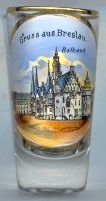
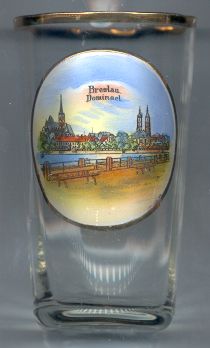
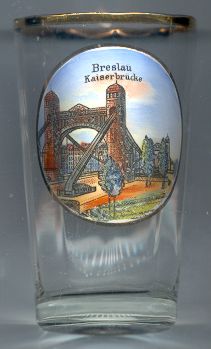
Glass no. 1463 [left] shows the  Cathedral Island (Ostrów Tumski, Dominsel).
To the left, the
Cathedral Island (Ostrów Tumski, Dominsel).
To the left, the
 Church
Church Cathedral of St. John the Baptist
Cathedral of St. John the Baptist
The  Emperor Bridge (Kaiserbrücke) [right] is certainly the
best-known of the numerous bridges of Wrocław. The suspension bridge (span 127 m) was built in
1908–1910 by the architects and engineers Richard Plüddemann and Karl Klimm. Today the bridge is called
Most Grunwaldski (Grunwald Bridge).
Emperor Bridge (Kaiserbrücke) [right] is certainly the
best-known of the numerous bridges of Wrocław. The suspension bridge (span 127 m) was built in
1908–1910 by the architects and engineers Richard Plüddemann and Karl Klimm. Today the bridge is called
Most Grunwaldski (Grunwald Bridge).
Another glass in this collection shows a view of Inowrocław in the Polish voivodship of
Kuyavia-Pomerania.
![[scale]](lineal.jpg)